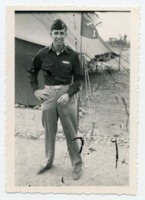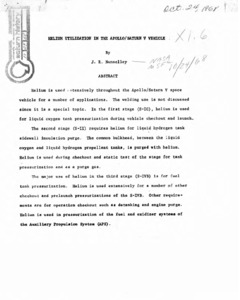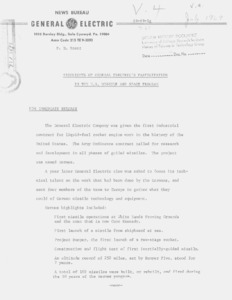
Browse Items (8239 total)
Sort by:
-
"H-1 rocket engine: models H-1C and H-1D : technical manual engine data."
Poor jpeg of a screenshot of a word-document. -
"Handshake in Space" (Apollo-Soyuz: U.S. and Soviet rendezvous in space)
A photo of Thomas P. Stafford and Alexei Leonov shaking hands in space after a successful docking between the Apollo and Soyuz spacecrafts. -
"Haskins Makes Quick Change from Civilian Ph.D. to Pfc."
Clipping from the Redstone Rocket, March 2, 1954. The article highlights Haskins' background as a physicist and his role in the 9330 Technical Service Unit. -
"Helium Utilization in the Apollo/Saturn V Vehicle."
Helium is used extensively throughout the Apollo/Saturn V space vehicle for a number of applications. The welding use is not discussed since it is a special topic. In the first stage (S-IC), helium is used for liquid oxygen tank pressurization during vehicle checkout and launch. -
"Hey! Why Don't You Drink It Straight Out of the Can?; Dispose of Hazardous Material Only at Authorized Recycling Centers"
Man dumping hazardous materials straight into water supply -
"High Energy Missions for Saturn."
Presented to Society of Automotive Engineers, Advanced Launch Vehicle & Propulsion Systems. When the Apollo lunar landing project is complete, the Saturn and Apollo hardware will only have begun to realize their ultimate potential for space exploration. The immense reserve of Apollo technology, facilities, and booster capability can then be directed to the achievement of national goals which lie far beyond the initial lunar landing. In achieving the Apollo lunar objectives, large investments will have been made in launch facilities, tracking systems, propulsion techniques, reentry systems, lunar landing systems and rendezvous technologies. Although developnent in these specialized areas has been tailored to the needs of Apollo, numerous studies by NASA and industry have demonstrated the feasibility of using the spacecraft, launch vehicles, and operating techniques for missions far more complex than lunar landings. Amortization of this hardware will prove cost-effective for missions of more sophisticated applications. -
"Highlights of General Electric's Participation in the U.S. Missile and Space Program."
Press release covering the system of functional management in NASA.









